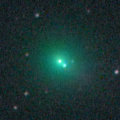
|
Brightened rapidly, and it reached to 5 mag in early June (June 5, Yoshimi Nagai). It will approach to the sun down to 0.4 A.U. in July, and it was expected to reach up to 2-3 mag. However, its brightening has stopped after that. It was 4.9 mag in late June (June 24, Carlos Labordena). Now it is not observable. In the Southern Hemisphere, it will appear in the morning sky at 9 mag in late Augut. Then it keeps observable while fading rapidly. In the Northern Hemisphere, it is will never be observable again.
Date(TT) R.A. (2000) Decl. Delta r Elong. m1 Best Time(A, h)
July 3 7 20.58 35 11.4 1.305 0.405 14 5.2 21:03 (138, -4)
July 10 7 59.91 24 31.1 1.411 0.450 10 5.4 21:00 (129,-10)
|
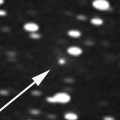
|
Brightened rapidly. Now it is so bright as 8.8 mag (June 22, Juan Jose Gonzalez). It keeps observable bright as 9-10 mag for a long time until autumn.
Date(TT) R.A. (2000) Decl. Delta r Elong. m1 Best Time(A, h)
July 3 23 51.98 -6 52.4 0.762 1.423 105 9.4 3:04 (319, 39)
July 10 0 11.25 -7 8.7 0.735 1.424 107 9.3 3:09 (323, 40)
|
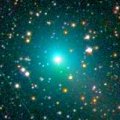
|
It brightened up to 7.9 mag in April and May (May 5, Juan Jose Gonzalez). Now it is fading. But it is still bright as 8.4 mag (June 22, Juan Jose Gonzalez). It keeps observable for a long time until when it fades out in the Northern Hemisphere. It will be visible visually until autumn, although it will be low in July.
Date(TT) R.A. (2000) Decl. Delta r Elong. m1 Best Time(A, h)
July 3 7 32.61 62 49.2 2.325 1.688 40 10.2 21:03 (156, 17)
July 10 7 41.26 60 44.1 2.415 1.741 38 10.5 21:00 (156, 15)
|

|
It passes the perihelion in August. But the condition of this apparition is bad. It is not observable in the Northern Hemisphere. In the Southern Hemisphere, it appears in the evening sky at 9 mag in late August, then it will keep observable while fading rapidly.
Date(TT) R.A. (2000) Decl. Delta r Elong. m1 Best Time(A, h)
July 3 5 7.16 28 43.1 1.705 0.868 23 11.0 3:04 (236, 2)
July 10 5 50.21 28 49.4 1.607 0.743 20 10.4 3:09 (234, 0)
|
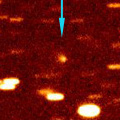
|
It brightened up to 15.5 mag in January (Jan. 31, C. Rinner, F. Kugel). It is not observable now. The condition of this apparition is bad. It will reach up to 11-12 mag from spring to autumn, but it is not observable.
Date(TT) R.A. (2000) Decl. Delta r Elong. m1 Best Time(A, h)
July 3 5 59.96 21 28.1 2.342 1.358 11 11.6 3:04 (233,-12)
July 10 6 25.09 20 29.1 2.339 1.361 11 11.6 3:09 (235,-11)
|
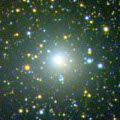
|
It reached up to 7.7 mag in last summer (Aug. 13, Chris Wyatt). It is fading now. It has already faded down to 11.5 mag (June 19, Marco Goiato). In the Southern Hemisphere, it keeps observable for a long time after this. In the Northern Hemisphere, it is only observable in the extremely low sky. It will be getting lower gradually, then it will never be observable again.
Date(TT) R.A. (2000) Decl. Delta r Elong. m1 Best Time(A, h)
July 3 18 48.61 -45 42.7 3.647 4.602 157 11.9 0:07 ( 0, 9)
July 10 18 34.71 -46 32.3 3.709 4.647 154 12.0 23:20 ( 0, 8)
|
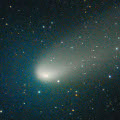
|
It reached up to 9.2 mag in March (Mar. 20, Marco Goiato). Now it is fading, but still bright as 11.4 mag (June 16, Marco Goiato). It keeps observable in a good condition for a long time. It keeps observable until autumn when it fades down to 16 mag.
Date(TT) R.A. (2000) Decl. Delta r Elong. m1 Best Time(A, h)
July 3 14 28.37 -9 47.4 1.349 2.025 117 12.7 21:03 ( 27, 41)
July 10 14 35.88 -10 43.5 1.449 2.063 112 12.9 21:00 ( 31, 39)
|

|
Now it is 11.9 mag (June 18, Juan Jose Gonzalez). It will keep 12-13 mag until autumn. But it locates somewhat low in the Northern Hemisphere.
Date(TT) R.A. (2000) Decl. Delta r Elong. m1 Best Time(A, h)
July 3 21 13.48 -29 26.7 1.643 2.554 146 12.8 2:31 ( 0, 26)
July 10 21 10.48 -30 16.7 1.618 2.567 153 12.8 2:01 ( 0, 25)
|

|
Chris Wyatt reported it was visible visually at 11.3 mag on Apr. 25. But no other observations have been reported. The condition of this apparition is very bad. It will never be observable after this.
Date(TT) R.A. (2000) Decl. Delta r Elong. m1 Best Time(A, h)
July 3 6 29.57 20 26.8 1.957 0.948 4 13.4 3:04 (228,-17)
July 10 7 0.04 19 0.0 2.026 1.017 4 14.0 3:09 (230,-18)
|
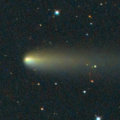
|
It brightened up to 9.5 mag in January (Jan. 13, Juan Jose Gonzalez). Now it is fading rapidly. But it is still bright as 12.3 mag (June 4, Juan Jose Gonzalez). It will be observable in good condition for a long time after this in the Northern Hemisphere. It keeps visible visually until summer. In mid March, the nuclear fragmentation was observed.
Date(TT) R.A. (2000) Decl. Delta r Elong. m1 Best Time(A, h)
July 3 14 36.60 56 55.2 3.642 3.686 84 14.1 21:03 (156, 65)
July 10 14 39.57 55 30.9 3.730 3.741 82 14.3 21:00 (149, 64)
|

|
Great outburst up to 11 mag occured on Feb. 2. Another new minor outburst occured on Apr. 16 (Albert Sanchez Caso). It is bright as 11.8 mag still now (June 3, Juan Jose Gonzalez). It will be unobservable soon.
Date(TT) R.A. (2000) Decl. Delta r Elong. m1 Best Time(A, h)
July 3 9 42.90 10 54.7 6.916 6.218 43 14.2 21:03 (100, 5)
July 10 9 47.17 10 30.5 6.989 6.220 38 14.2 21:00 (102, 1)
|

|
Brightening rapidly. Now it is 16.6 mag (June 14, C. Rinner, F. Kugel). This apparition is best condition. It will approach to the earth down to 0.12 A.U. in October, and brighten up to 5 mag. It will be visible with naked eyes. In the Northern Hemisphere, it keeps observable all through this apparition until 2011 June when it fades down to 17 mag.
Date(TT) R.A. (2000) Decl. Delta r Elong. m1 Best Time(A, h)
July 3 22 5.90 13 2.0 1.097 1.826 119 14.9 3:04 (348, 68)
July 10 22 11.87 15 24.3 0.992 1.763 122 14.4 3:01 ( 0, 70)
|

|
Now it is 15.2 mag (June 14, Hidetaka Sato). It is expected to keep so bright as 6-8 mag for a long time from 2011 to 2012, and to be observable in good condition in the Northern Hemisphere. In 2010, it is observable in good condition in the Southern Hemisphere while brightening slowly. It locates low in the Northern Hemisphere, but it keeps observable until the end of 2010.
Date(TT) R.A. (2000) Decl. Delta r Elong. m1 Best Time(A, h)
July 3 23 55.67 -33 27.2 5.646 6.112 112 15.1 3:04 (333, 15)
July 10 23 53.34 -33 57.3 5.496 6.052 118 15.0 3:09 (340, 18)
|
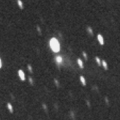
|
Now it is 15.3 mag (June 15, Hidetaka Sato). It is also visible visually at 14.5 mag (Apr. 10, Juan Jose Gonzalez). It keeps observable at 15 mag for a long time in 2010.
Date(TT) R.A. (2000) Decl. Delta r Elong. m1 Best Time(A, h)
July 3 17 37.85 42 4.5 4.073 4.567 112 15.1 22:51 (180, 83)
July 10 17 34.22 42 16.3 4.090 4.559 111 15.1 22:20 (180, 83)
|
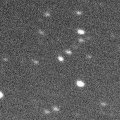
|
Now it is 15.0 mag (June 2, Hidetaka Sato). It keeps bright as 14-15 mag for a long time after this until 2013. It is observable in good condition in the Southern Hemisphere. However, it is not observable in the Northern Hemisphere.
Date(TT) R.A. (2000) Decl. Delta r Elong. m1 Best Time(A, h)
July 3 14 31.72 -48 7.0 6.113 6.737 124 15.2 21:03 ( 13, 5)
July 10 14 28.03 -47 58.9 6.167 6.708 118 15.2 21:00 ( 17, 4)
|
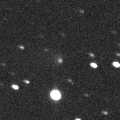
|
Now it is 15.6 mag (June 20, Catalina Sky Survey). It will be observable at 13-14 mag for a long time from 2011 to 2012. In 2010, it is observable at 15-16 mag in good condition from spring to autumn.
Date(TT) R.A. (2000) Decl. Delta r Elong. m1 Best Time(A, h)
July 3 21 37.99 1 57.7 6.322 7.037 131 15.4 2:56 ( 0, 57)
July 10 21 32.89 1 46.2 6.206 7.004 138 15.3 2:23 ( 0, 57)
|
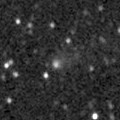
|
Now it is visible visually at 14.3 mag (May 21, Alan Hale). It keeps observable for a long time until September when it becomes fainter than 18 mag.
Date(TT) R.A. (2000) Decl. Delta r Elong. m1 Best Time(A, h)
July 3 16 18.11 -24 5.8 0.955 1.885 145 15.7 21:33 ( 0, 31)
July 10 16 22.68 -23 32.0 1.021 1.916 140 15.9 21:10 ( 0, 31)
|
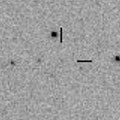
|
It had been unobservable for a while, but it is getting observable in the morning sky now. Now it is 16.1 mag (June 13, C. Rinner, F. Kugel). It keeps observable after this while fading gradually.
Date(TT) R.A. (2000) Decl. Delta r Elong. m1 Best Time(A, h)
July 3 3 49.95 49 32.8 2.822 2.200 43 15.9 3:04 (226, 25)
July 10 4 9.23 51 41.9 2.823 2.244 46 16.0 3:09 (225, 28)
|
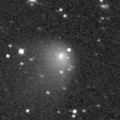
|
Bright new comet discovered as a bright stellar object of 12.5 mag on Apr. 16. It was not detected, fainter than 20 mag, on the previous day (Apr. 15, Catalina Sky Survey). It was discovered just after the sudden outburst. It is bright as 12.0 mag still now (June 6, Jose Guilherme S. Aguiar), but it looks diffuse. It has faded down to 14.7 mag by CCD observations (June 17, Toni Scarmato).
Date(TT) R.A. (2000) Decl. Delta r Elong. m1 Best Time(A, h)
July 3 13 20.67 -0 44.1 2.842 3.149 98 16.1 21:03 ( 52, 40)
July 10 13 24.19 -1 41.0 2.940 3.153 92 16.5 21:00 ( 56, 36)
|

|
Now it is 16.0 mag (June 12, Toshiyuki Takahashi). It was observed as 15-16 mag in early 2009. In 2010, it was also observed at 16 mag in good condition from winter to spring. But it will be getting lower in the evening sky after this. It will be too low to observe in August.
Date(TT) R.A. (2000) Decl. Delta r Elong. m1 Best Time(A, h)
July 3 13 22.10 -3 29.5 3.435 3.738 99 16.1 21:03 ( 49, 38)
July 10 13 24.87 -4 0.9 3.541 3.745 93 16.2 21:00 ( 54, 34)
|

|
It brightened up to 11 mag in spring and summer in 2009. Appearing in the morninig sky again. Now it is 16.3 mag (June 2, Ken-ichi Kadota). It keeps observable after this until autumn when it becomes fainter than 18 mag while fading gradually. But it locates somewhat low in the Northern Hemisphere.
Date(TT) R.A. (2000) Decl. Delta r Elong. m1 Best Time(A, h)
July 3 19 53.23 -26 17.9 2.119 3.111 164 16.7 1:11 ( 0, 29)
July 10 19 47.16 -26 34.6 2.127 3.137 171 16.8 0:38 ( 0, 28)
|

|
Now it is 16.7 mag (June 13, Hidetaka Sato). It will be observable at 17 mag in good condition in summer.
Date(TT) R.A. (2000) Decl. Delta r Elong. m1 Best Time(A, h)
July 3 20 55.80 -4 41.3 2.523 3.398 143 16.8 2:14 ( 0, 50)
July 10 20 39.69 -3 43.0 2.469 3.404 152 16.8 1:30 ( 0, 51)
|
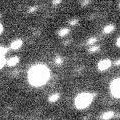
|
It was observed at 17 mag in summer and autumn in 2009. It will be observable again at 17 mag in good condition in summer and autumn also in 2010.
Date(TT) R.A. (2000) Decl. Delta r Elong. m1 Best Time(A, h)
July 3 2 11.32 19 39.1 2.768 2.491 63 17.1 3:04 (266, 30)
July 10 2 21.74 20 22.6 2.705 2.505 67 17.1 3:09 (269, 35)
|
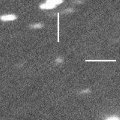
|
It keeps 17 mag for a long time from 2009 to 2012. It is observable in good condition in the Northern Hemisphere.
Date(TT) R.A. (2000) Decl. Delta r Elong. m1 Best Time(A, h)
July 3 2 32.19 20 38.5 8.758 8.277 58 17.4 3:04 (262, 27)
July 10 2 31.99 20 48.8 8.638 8.266 65 17.4 3:09 (267, 33)
|

|
Now it is 17.0 mag (June 9, Yasukazu Ikari). It keeps observable at 17-18 mag for a long time until 2011 summer.
Date(TT) R.A. (2000) Decl. Delta r Elong. m1 Best Time(A, h)
July 3 20 1.81 10 49.4 3.343 4.187 141 17.4 1:20 ( 0, 66)
July 10 19 49.19 11 34.2 3.292 4.167 145 17.4 0:40 ( 0, 67)
|
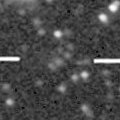
|
Now it is 17.2 mag (June 2, Ken-ichi Kadota). It keeps observable at 17.5 mag in good condition for a long time in 2010.
Date(TT) R.A. (2000) Decl. Delta r Elong. m1 Best Time(A, h)
July 3 16 51.33 84 24.0 5.090 4.871 71 17.4 21:59 (180, 41)
July 10 16 8.30 82 45.1 5.081 4.877 72 17.4 21:00 (180, 42)
|

|
Now it is 18.8 mag (May 18, Hidetaka Sato). It returned as bright as expected. It will reach up to 16 mag from August to November, and will be observable in good condition.
Date(TT) R.A. (2000) Decl. Delta r Elong. m1 Best Time(A, h)
July 3 23 48.48 20 57.3 1.563 1.930 94 17.7 3:04 (290, 60)
July 10 23 59.23 23 3.2 1.491 1.912 97 17.5 3:09 (292, 65)
|
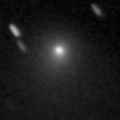
|
Now it is 17.7 mag (June 4, P. Bacci). It will be fainter than 18 mag soon.
Date(TT) R.A. (2000) Decl. Delta r Elong. m1 Best Time(A, h)
July 3 18 35.73 43 29.2 6.693 7.159 113 17.8 23:49 (180, 82)
July 10 18 32.06 43 22.5 6.742 7.209 113 17.9 23:18 (180, 82)
|
|
![]()
 43P/Wolf-Harrington
43P/Wolf-Harrington C/2006 W3 ( Christensen )
C/2006 W3 ( Christensen ) 81P/Wild 2
81P/Wild 2 65P/Gunn
65P/Gunn 141P/Machholz 2
141P/Machholz 2 C/2007 Q3 ( Siding Spring )
C/2007 Q3 ( Siding Spring ) 29P/Schwassmann-Wachmann 1
29P/Schwassmann-Wachmann 1 103P/Hartley 2
103P/Hartley 2 C/2009 P1 ( Garradd )
C/2009 P1 ( Garradd ) C/2008 FK75 ( Lemmon-Siding Spring )
C/2008 FK75 ( Lemmon-Siding Spring ) C/2009 F4 ( McNaught )
C/2009 F4 ( McNaught ) C/2006 S3 ( LONEOS )
C/2006 S3 ( LONEOS ) P/2010 A5 ( LINEAR )
P/2010 A5 ( LINEAR ) 126P/IRAS
126P/IRAS P/2010 H2 ( Vales )
P/2010 H2 ( Vales ) 74P/Smirnova-Chernykh
74P/Smirnova-Chernykh 116P/Wild 4
116P/Wild 4 C/2010 J2 ( McNaught )
C/2010 J2 ( McNaught ) 219P/2009 H1 ( LINEAR )
219P/2009 H1 ( LINEAR ) C/2008 S3 ( Boattini )
C/2008 S3 ( Boattini ) C/2009 UG89 ( Lemmon )
C/2009 UG89 ( Lemmon ) C/2007 VO53 ( Spacewatch )
C/2007 VO53 ( Spacewatch ) 236P/2010 K1 ( LINEAR )
236P/2010 K1 ( LINEAR ) C/2006 Q1 ( McNaught )
C/2006 Q1 ( McNaught )![]()




















